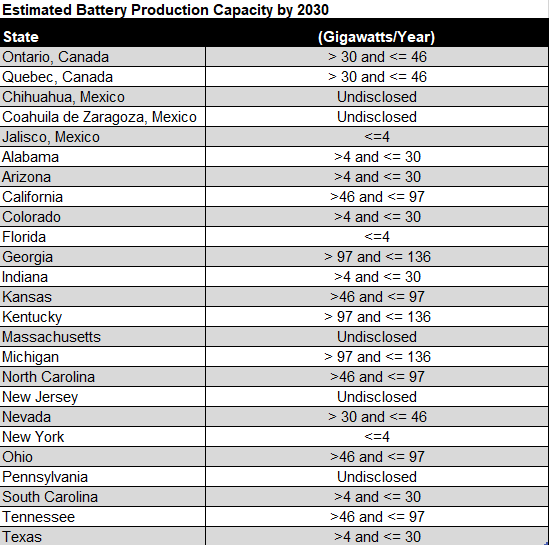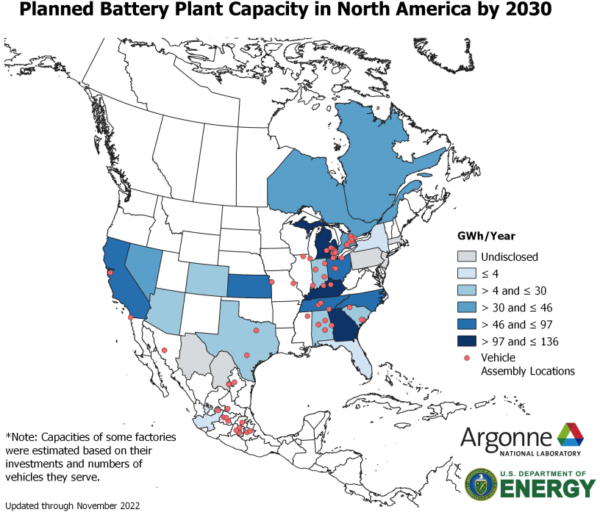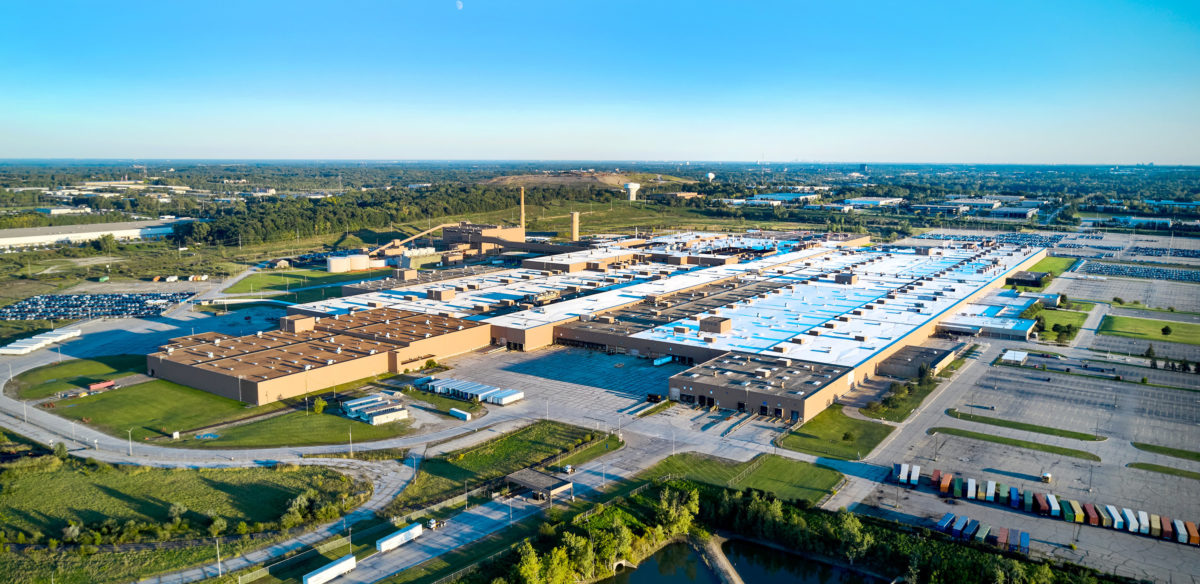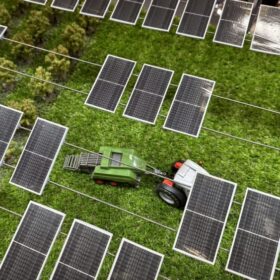Electric vehicle battery manufacturing capacity in North America is projected to increase to 1,000 GWh/year by 2030, representing a 20 times increase from 55 GWh/year of manufacturing capacity in 2021, thanks primarily to stimulus funding from the Inflation Reduction Act.
The majority of new EV battery plants are scheduled to begin production between 2025 and 2030. By then, production capacity will be capable of supporting the manufacture of roughly 10 to 13 million fully electric vehicles per year.
In a report by the Department of Energy in conjunction with Argonne National Laboratory, planned battery capacity production is seeing the highest penetration rate in the Midwest and Southeast, with historic Rust Belt states across the Midwest having facilities devoted to battery production. To optimize supply chain logistics, many battery facilities will be co-located within existing automotive plants.
Michigan, Kentucky and Georgia have the highest estimated battery production capacity through 2030, at 97 GW per year to 136 GW/y, followed by Ohio, Kansas, Georgia, North Carolina, Tennessee and California, with 46 GW/y to 97 GW/y of estimated battery production.
By existing vehicle production locations, the Midwest has a good number of existing facilities for battery use, at 25 facilities, while surprisingly Ontario has nine facilities and Mexico has 30 facilities that are flagged for planned EV battery capacity.

In addition to vehicle facility co-locations for EV battery production, the concentration of 2030 battery plant announcements broadly correlates to states in the same region seeing the highest rate of new EV registrations. Southeast states like Georgia and Florida, which tallied 128,000 new EV registrations, are seeing a manufacturing uptick across the historic manufacturing hub of Alabama, Mississippi and Georgia. West Coast states of California (878,000) and Washington (91,000) seeing a high EV registration are broadly seeing production capacity coming online in the next few years in California, Arizona and Nevada.
A few states with existing vehicle assembly plants such as Illinois, Missouri, and Mississippi, have not telegraphed plans for additional 2030 goal EV battery production capacity, despite having five existing vehicle assembly locations.
Since the landmark Inflation Reduction Act passed in August, auto makers and battery companies have announced $11 billion in new investments into the North American EV battery supply chain. Panasonic opened a $4 billion factory in Kansas and is now eyeing Oklahoma, Toyota increased its commitment to a North Carolina battery production facility from $1.3 billion to $3.8 billion, and Statevolt intends to spend $4 billion on a factory in California.

Through late 2021, 2.3 million vehicles or just over 4% of North American vehicles on the road were EVs or plug-in hybrid EVs, with 630,000 EVs sold in 2021 alone, representing sales growth of 92% compared to 457,000 of sales in 2020.
Since 2010, 65% of EVs sold in the U.S. have been assembled here, and over 110 GWh of lithium-ion batteries have been installed in those vehicles to date. The average range for EVs reached 290 miles in 2021, with 2.5 billion gallons of gasoline cumulatively saved since 2010, reducing consumer fuel costs by $1.3 billion in 2021. EVs drove 19.1 billion miles in 2021 using 6,100 GWh of electricity, saving 700 million gallons of gasoline.
As of December 2021, Tesla (42.9%), General Motors (11.6%), Toyota (8%), Ford (6.8%) and Nissan (7.1%) generated more than 75% of total EV sales in North America, with four Tesla models, the Nissan Leaf, Chevrolet Bolt/Volt, Ford Fusion Energi and Toyota Prius making up some of the 14 most popular EV models by sales of over 30,000 units apiece in 2021.
California, Washington D.C., Hawaii, Washington, Oregon, Vermont and Colorado all have total EV shares above 1% relative to total cars on the road, with California holding more than 3% ratio of EVs to conventional vehicles on the road for late 2021, with Hawaii and West Coast states to Colorado following the Sunshine State.
The rate of electric vehicle adoption will likely increase substantially in coming years as states issue EV mandates.
Additional data and reports can be accessed from the DOE here. The research report was authored by Argonne’s David Gohlke, Yan Zhou, Xinyi Wu and Calista Courtney.
This content is protected by copyright and may not be reused. If you want to cooperate with us and would like to reuse some of our content, please contact: editors@pv-magazine.com.









I’m pretty sure battery production will beat that much. I hope this does not cause problems for the ecosystem as well.
I just read the article and I’m so impressed! This is a huge step forward in the fight against climate change, and it’s amazing to see companies making such a commitment. We need to continue to invest in renewable energy and EV technology to reduce our carbon footprint and help the planet. Great job to everyone involved!
Thanks, for sharing the article; reaching a production capacity of 1 TWh annually by 2030 is a significant leap forward. This will not only strengthen the EV industry but also create a more sustainable transportation sector.
Exciting growth ahead for EV battery production in North America! Reaching 1 TWh annually by 2030 could be a major boost for clean energy and job creation.
This forecast signals rapid growth in North American EV battery manufacturing, reflecting strong industry investment and rising demand for electric vehicles. Reaching 1 TWh annually by 2030 would mark a major milestone in achieving regional energy independence and supporting the clean transportation shift.